What is the Market Profile and how to use it?

What is the Market profile indicator?
The Market Profile indicator as know as Volume Profile is a powerful tool for forex traders that provides valuable insights into the market structure and dynamics. It is a visual representation of the trading activity over a specific period, which shows the distribution of price and volume across different price levels.
The Market Profile indicator is based on the concept of market profiling, which divides the market into different price levels or “value areas.” Each value area represents a price range where the market has spent a significant amount of time, and where buyers and sellers have established a balance of power.
What information does it give you?
By analyzing the Market Profile indicator, traders can gain a deeper understanding of the market dynamics and identify potential trading opportunities. Some of the key information that the Market Profile indicator provides include:
– Price levels: The indicator shows the most significant price levels based on the volume traded at each level. This information can help trades to finde the supply and demand area better and faster.
– Volume distribution: The Market Profile indicator shows the distribution of volume across different price levels, which helps traders identify areas of high and low liquidity. Its like to identify order book area on the chart. This information can be useful for determining entry and exit prices and managing risk.
– Market structure: It can helps traders identify the market structure, whether it is trending, ranging, or consolidating. This information can be used to develop trading strategies that are suitable for the current market conditions. To use the Market Profile indicator for trades, traders need to understand how to read the indicator and interpret the information it provides.
The main components of the Market Profile
First, walk through some basic information about the Market profile. When drawing your Market/volume profile in the chart, you must become intimately familiar with the following values
High volume node (HVN)
HVN stands for High Volume Node, which is a price level where a high amount of trading volume has occurred. It is essentially a point of balance where buyers and sellers are equally matched, resulting in a prolonged period of price consolidation. HVNs are identified through the use of volume profiles, which display the volume of trades that occurred at each price level.
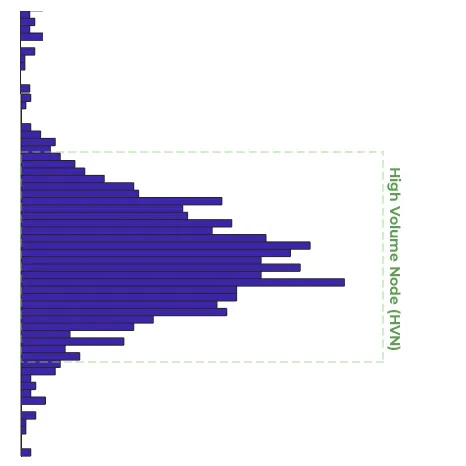
Low volume node (LVN)
LVN is a term used in Market Profile analysis to represent a price level that has witnessed low trading activity. It is a point in the price range where the trading volume is significantly lower than the rest of the market. LVNs are identified through the Market Profile chart, where the volume distribution is plotted against price levels. These nodes are considered significant because they reflect a lack of demand or supply at that price, which could indicate a potential shift in market sentiment.
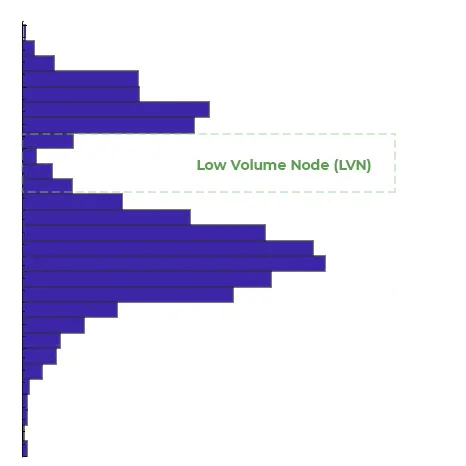
Point of Control (POC):
The main key level in the Market profile indicator is the Point of Control or POC which represents the price level where the most trading activity occurred during a given period. It is usually represented by the longest horizontal line in a market profile chart, which shows the distribution of trading activity over time. The POC provides insight into the market sentiment and helps to identify key levels of support and resistance.
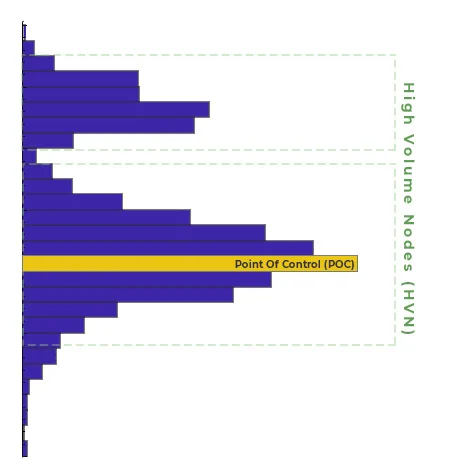
Value Area (VA)
VA stands for Value Area, which is the range of price levels where a certain percentage (usually 70%) of trading volume has occurred. it shows you the most trades area where buyers and sellers tried to trade their assets (Areas of high supply and demand)
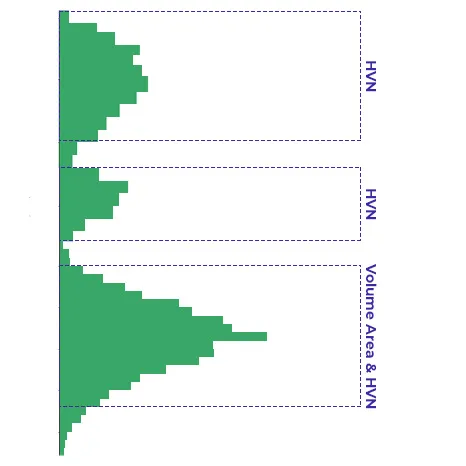
How to read the chart with Market Profile?
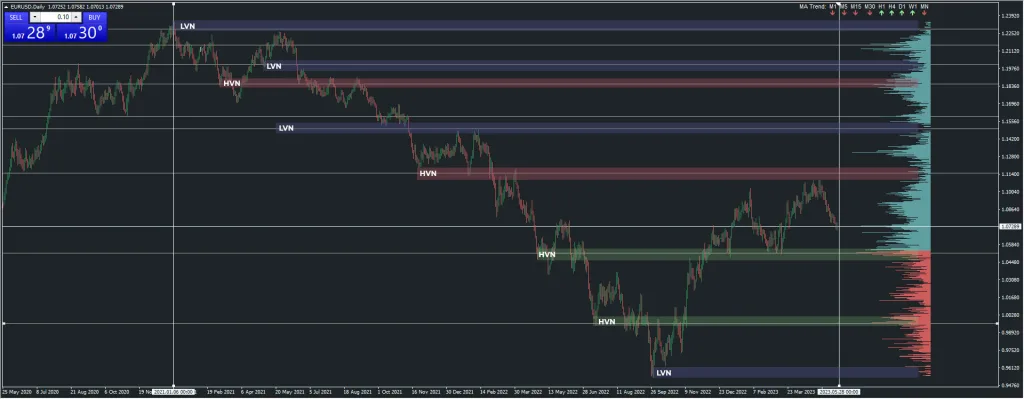
Here are some tips for using the Market Profile indicator effectively:
1. Identify the pivot levels and volume distribution
The first step is to identify the value areas based on the volume traded at each price level. (Image above) Traders should look for areas with the highest and lowest volume and consider them as potential support or resistance levels. You should also analyze the volume distribution across different price levels to identify areas of high and low liquidity. This information can help you to determine the strength of support and resistance levels and identify potential breakout targets too.
Use the POC to determine the fair value of an asset. A special price is used to make trading decisions based on whether the market is bullish or bearish. The most supply and demand occurs in POC levels. Usually in this area, you will see a strong breakout after the battle between buyers and sellers.
Use HVNs as a basis for support and resistance levels, as they indicate where large numbers of market participants are willing to buy or sell, making it a significant level to watch out for. The HVN is an essential tool for market profile traders as it helps to identify key levels of interest with a high probability of price action.
Traders use LVNs as support or resistance levels, and they may also use them to place trades or take profit. In summary, LVNs are essential indicators in Market Profile analysis that traders use to make informed trading decisions.
2. Determine the market structure
Traders should use the Market Profile indicator to determine the market structure, whether it is trending, ranging, or consolidating. This information can be used to develop trading strategies that are suitable for the current market conditions. Use VA Volume Area and POC to determine the high volume area as side or range market.
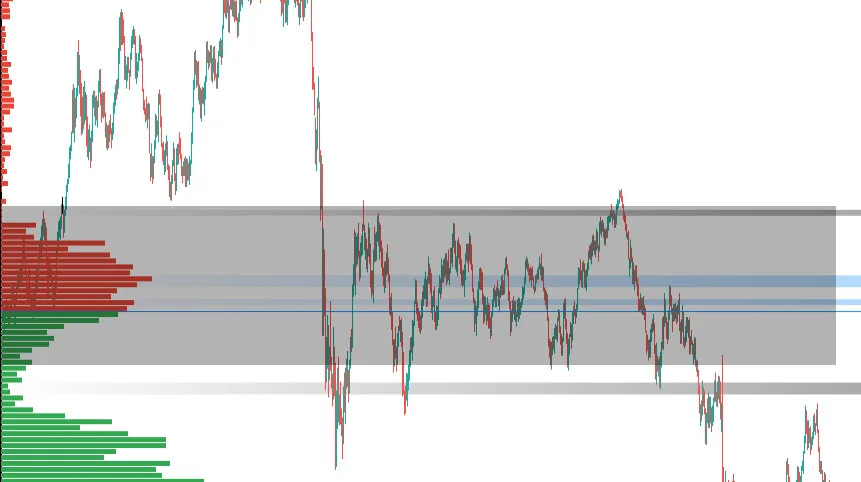
3. Use the information for trades
Once traders have analyzed the Market Profile indicator, they can use the information to develop trading strategies that are based on the market structure, support and resistance levels, and potential breakout targets. Traders can also use the Market profile to manage risk by setting stop-loss and taking profit targets based on the information provided like POC and all other HVNs and LVNs.
Order Squeeze
Order Squeeze Easy to use an indicator that shows you squeezed levels of the price that have a high potential to retrace, reverse or break with a high volume of traders. you can buy these tools from Metatrader markets


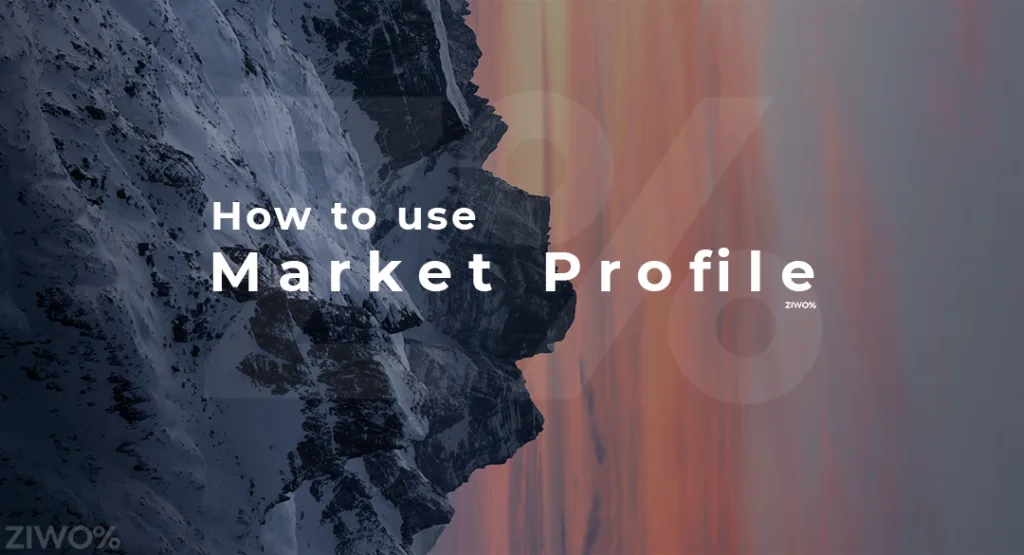
How to use Market Profile in Trading?
By analyzing the indicator, traders can identify potential trading opportunities, develop trading strategies, and manage risk effectively. However, traders should also use other technical indicators and fundamental analysis to confirm their trading decisions and avoid relying solely on the Market Profile indicator.
💹 Enter for a buy position
If you’re looking to trade and enter a buy position based on the market profile indicator, here are some tips to keep in mind:
Manual trading tools. Fundamental trader
1. Looking for a long trend direction
It is always advisable to trade in the current direction if you want to be a successful trader.
If you like to buy an asset, to reduce your risk and faults, it’s better to find a long-term upside direction and trade when a short-term market correction or a downside retracement occurs. When you identify the long-term trend, wait for a correction and trade in a lower (cheaper) price. Price action can help you more to read the market and detect the movement direction.
2. Identify key levels
identifying the key levels of the market by finding the HVN and LVN areas. all the peaks, Hills, dimples, dents, and valleys can be support or resistance levels. the market can react to any of them. you can scalp on it or use the lowest key levels for entering a long position. Note this, the cheaper price has a lower risk for buying.
3. Wait for confirmation
While identifying support levels is important, it’s also essential to wait for confirmation before entering a buy position. This means waiting for the price to actually start moving up from the support level before making your trade. This can help you avoid false breakouts and ensure that you’re entering the market at a time when the price is actually likely to rise.
Then you can also use another technical method to confirm your buy position. For example, you might use a moving average crossover or an oscillator to confirm that the trend changing. It can help you build a more accurate trading strategy. look at the below images. you have strong levels for buying but you don’t have any confirmations (1). so wait for next levels (2)
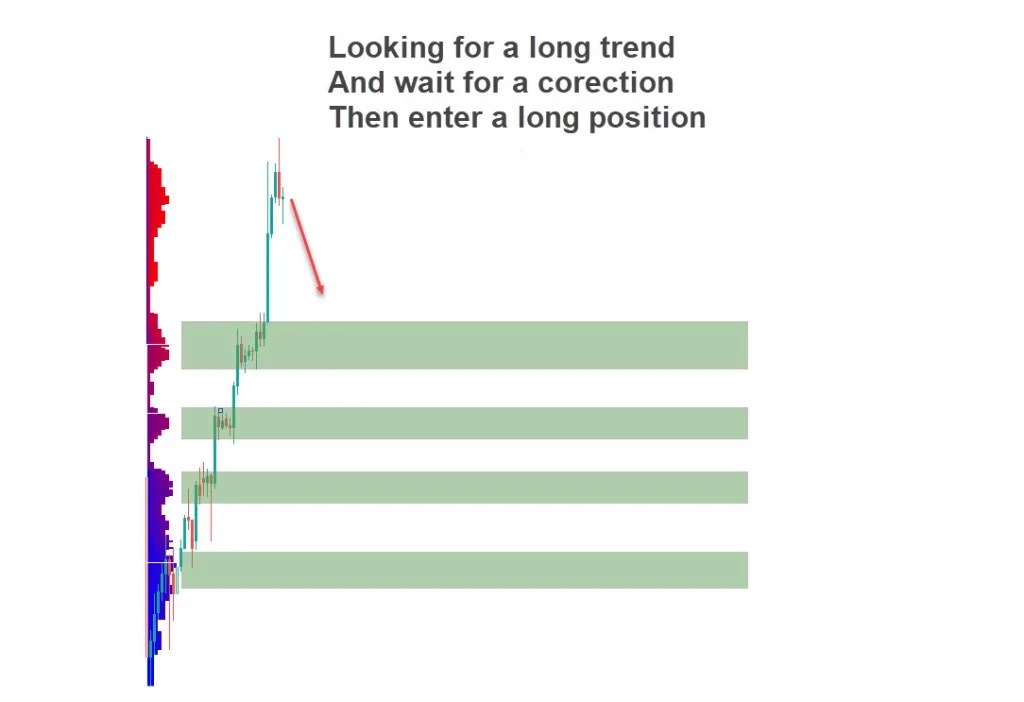
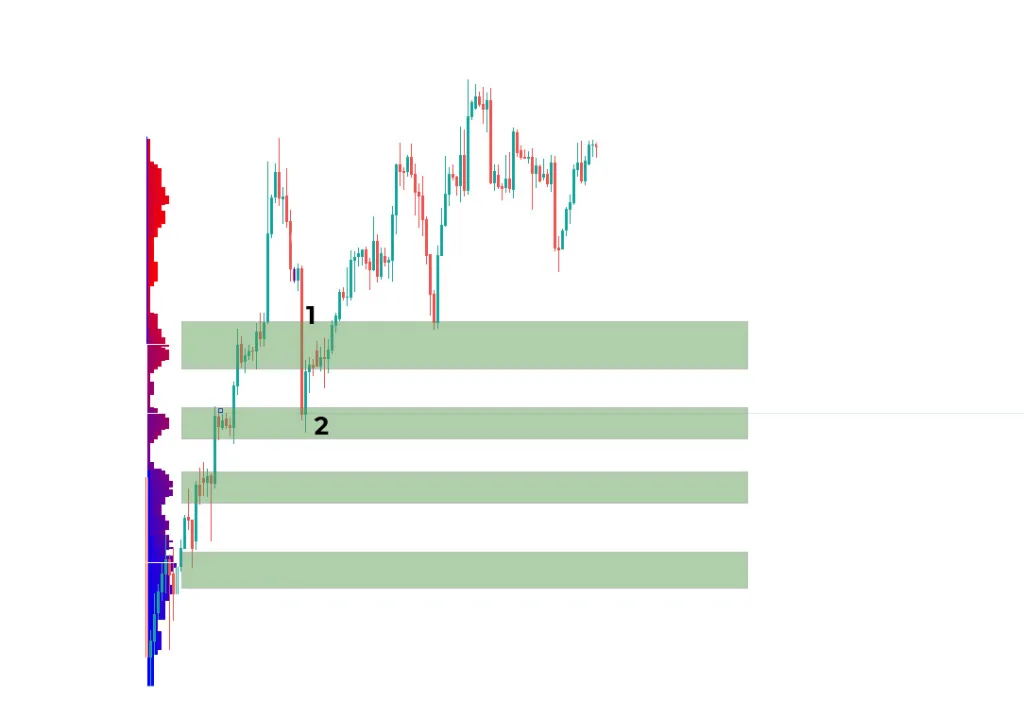
4. Set your stop loss
Once you’ve entered your buy position, it’s important to set your stop loss to protect your investment. This should be based on your risk tolerance and the volatility of the asset you’re trading.
Using the key levels in step 2, identify supports and set your stop below them.
So, in short, for trading with Market profile
– Look at the shape of the market profile curve and identify areas of highest and lowest volume areas
– Look for price levels that have been accepted by the market for an extended period of time
– Use the POC as a reference point for potential entry levels
– Consider a buy position when the price breaks above a previous high volume area or resistance level
– Use technical ways or trend indicators in a lower timeframe to confirm the signals
– Set a stop loss order below the entry-level and below a lower POC area to limit potential losses
– Take profits at predetermined levels or use a trailing stop to ride the trend.
📉 Enter for a Sell position
You can use all the learning information above for the sell position too.
The infrastructure is this:
- Find a long-term downtrend market that is held by sellers (sellers are bigger and stronger)
- Find and draw all key levels, HVN, LVN, and POC areas.
- Wait for a retracement/correction in the market and try to sell the assets at the highest possible price (Sell when the asset is expensive)
- apply proper risk for your trade
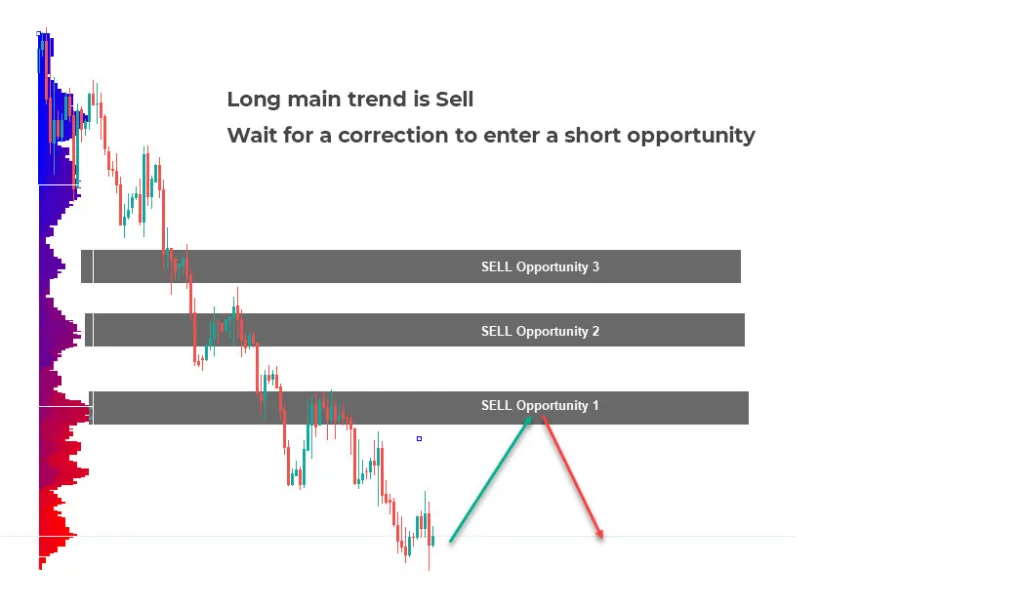
Ziwox Terminal | Ziwox calendar | Market Summary


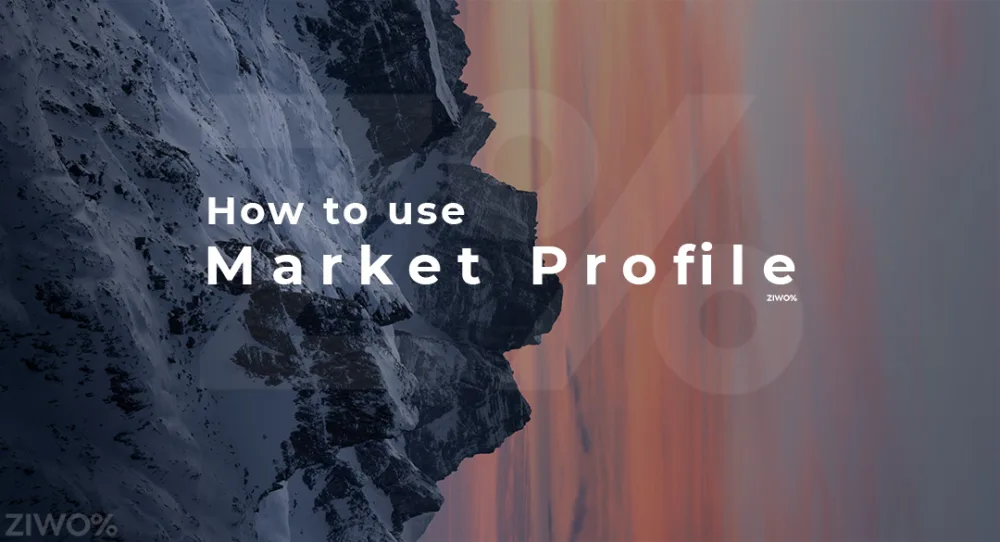
Leave a Reply
You must be logged in to post a comment.